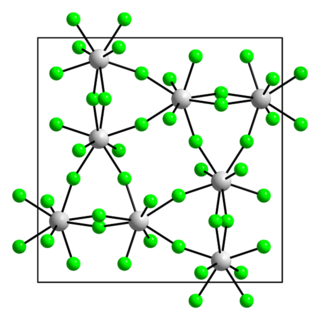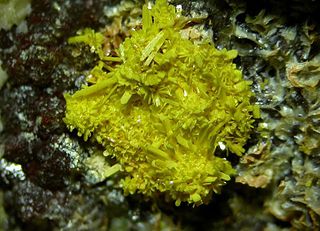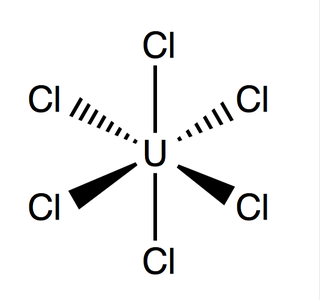
Uranium hexafluoride, sometimes called hex, is an inorganic compound with the formula UF6. Uranium hexafluoride is a volatile and toxic white solid that reacts with water, releasing corrosive hydrofluoric acid. The compound reacts mildly with aluminium, forming a thin surface layer of AlF3 that resists any further reaction from the compound. UF6 is used in the process of enriching uranium, which produces fuel for nuclear reactors and nuclear weapons.

Yellowcake is a type of uranium concentrate powder obtained from leach solutions, in an intermediate step in the processing of uranium ores. It is a step in the processing of uranium after it has been mined but before fuel fabrication or uranium enrichment. Yellowcake concentrates are prepared by various extraction and refining methods, depending on the types of ores. Typically, yellowcakes are obtained through the milling and chemical processing of uranium ore, forming a coarse powder that has a pungent odor, is insoluble in water, and contains about 80% uranium oxide, which melts at approximately 2880 °C.
Uranium fluoride can refer to:

Bromine pentafluoride, BrF5, is an interhalogen compound and a fluoride of bromine. It is a strong fluorinating agent.

Triuranium octoxide (U3O8) is a compound of uranium. It is present as an olive green to black, odorless solid. It is one of the more popular forms of yellowcake and is shipped between mills and refineries in this form.
The uranyl ion is an oxycation of uranium in the oxidation state +6, with the chemical formula UO2+
2. It has a linear structure with short U–O bonds, indicative of the presence of multiple bonds between uranium and oxygen. Four or more ligands may be bound to the uranyl ion in an equatorial plane around the uranium atom. The uranyl ion forms many complexes, particularly with ligands that have oxygen donor atoms. Complexes of the uranyl ion are important in the extraction of uranium from its ores and in nuclear fuel reprocessing.

Uranium trioxide (UO3), also called uranyl oxide, uranium(VI) oxide, and uranic oxide, is the hexavalent oxide of uranium. The solid may be obtained by heating uranyl nitrate to 400 °C. Its most commonly encountered polymorph, γ-UO3, is a yellow-orange powder.

Uranium tetrafluoride is the inorganic compound with the formula UF4. It is a green solid with an insignificant vapor pressure and low solubility in water. Uranium in its tetravalent (uranous) state is important in various technological processes. In the uranium refining industry it is known as green salt.

Uranyl peroxide or uranium peroxide hydrate (UO4·nH2O) is a pale-yellow, soluble peroxide of uranium. It is found to be present at one stage of the enriched uranium fuel cycle and in yellowcake prepared via the in situ leaching and resin ion exchange system. This compound, also expressed as UO3·(H2O2)·(H2O), is very similar to uranium trioxide hydrate UO3·nH2O. The dissolution behaviour of both compounds are very sensitive to the hydration state (n can vary between 0 and 4). One main characteristic of uranium peroxide is that it consists of small needles with an average AMAD of about 1.1 μm.

Ammonium diuranate or (ADU) ((NH4)2U2O7), is one of the intermediate chemical forms of uranium produced during yellowcake production. The name "yellowcake" originally given to this bright yellow salt, now applies to mixtures of uranium oxides which are actually hardly ever yellow. It also is an intermediate in mixed-oxide (MOX) fuel fabrication. Although it is usually called "ammonium diuranate" as though it has a "diuranate" ion U
2O2−
7, this is not necessarily the case. It can also be called diammonium diuranium heptaoxide. The structure is said to be similar to that of uranium dioxide dihydrate.

A uranate is a ternary oxide involving the element uranium in one of the oxidation states 4, 5 or 6. A typical chemical formula is MxUyOz, where M represents a cation. The uranium atom in uranates(VI) has two short collinear U–O bonds and either four or six more next nearest oxygen atoms. The structures are infinite lattice structures with the uranium atoms linked by bridging oxygen atoms.

Uranium tetrachloride is an inorganic compound, a salt of uranium and chlorine, with the formula UCl4. It is a hygroscopic olive-green solid. It was used in the electromagnetic isotope separation (EMIS) process of uranium enrichment. It is one of the main starting materials for organouranium chemistry.

Uranium pentafluoride is the inorganic compound with the chemical formula UF5. It is a pale yellow paramagnetic solid. The compound has attracted interest because it is related to uranium hexafluoride, which is widely used to produce uranium fuel. It crystallizes in two polymorphs, called α- and β-UF5.

The Fernald Feed Materials Production Center is a Superfund site located within Crosby Township in Hamilton County, Ohio, as well as Ross Township in Butler County, Ohio, in the United States. It was a uranium processing facility located near the rural town of New Baltimore, about 20 miles (32 km) northwest of Cincinnati, which fabricated uranium fuel cores for the U.S. nuclear weapons production complex from 1951 to 1989. During that time, the plant produced 170,000 metric tons uranium (MTU) of metal products and 35,000 MTU of intermediate compounds, such as uranium trioxide and uranium tetrafluoride.

Bergenite is a rare uranyl phosphate of the more specific phosphuranylite group. The phosphuranylite-type sheet in bergenite is a new isomer of the group, with the uranyl phosphate tetrahedra varying in an up-up-down, same-same-opposite (uuduudSSOSSO) orientation. All bergenite samples have been found in old mine dump sites. Uranyl minerals are a large constituent of uranium deposits.
Paulscherrerite, UO2(OH)2, is a newly named mineral of the schoepite subgroup of hexavalent uranium hydrate/hydroxides. It is monoclinic, but no space group has been determined because no single-crystal study has been done. Paulscherrerite occurs as a canary yellow microcrystalline powdery product with a length of ~500 nm. It forms by the weathering and ultimate pseudomorphism of uranium-lead bearing minerals such as metaschoepite. The type locality for paulscherrerite is the Number 2 Workings, Radium Ridge near Mount Painter, North Flinders Ranges, South Australia, an area where radiogenic heat has driven hydrothermal activity for millions of years. It is named for Swiss physicist Paul Scherrer, co-inventor of the Debye-Scherrer X-ray powder diffraction camera. Study of paulscherrerite and related minerals is important for understanding the mobility of uranium around mining sites, as well as designing successful strategies for the storage of nuclear weapons and the containment of nuclear waste.

Uranium hexachloride is an inorganic chemical compound of uranium in the +6 oxidation state. UCl6 is a metal halide composed of uranium and chlorine. It is a multi-luminescent dark green crystalline solid with a vapor pressure between 1-3 mmHg at 373.15 K. UCl6 is stable in a vacuum, dry air, nitrogen and helium at room temperature. It is soluble in carbon tetrachloride. Compared to the other uranium halides, little is known about UCl6.

Neptunium(VI) fluoride (NpF6) is the highest fluoride of neptunium, it is also one of seventeen known binary hexafluorides. It is an orange volatile crystalline solid. It is relatively hard to handle, being very corrosive, volatile and radioactive. Neptunium hexafluoride is stable in dry air but reacts vigorously with water.

Uranium acid mine drainage refers to acidic water released from a uranium mining site using processes like underground mining and in-situ leaching. Underground, the ores are not as reactive due to isolation from atmospheric oxygen and water. When uranium ores are mined, the ores are crushed into a powdery substance, thus increasing surface area to easily extract uranium. The ores, along with nearby rocks, may also contain sulfides. Once exposed to the atmosphere, the powdered tailings react with atmospheric oxygen and water. After uranium extraction, sulfide minerals in uranium tailings facilitates the release of uranium radionuclides into the environment, which can undergo further radioactive decay while lowering the pH of a solution.
Depleted uranium hexafluoride (DUHF; also referred to as depleted uranium tails, depleted uranium tailings or DUF6) is a byproduct of the processing of uranium hexafluoride into enriched uranium. It is one of the chemical forms of depleted uranium (up to 73-75%), along with depleted triuranium octoxide (up to 25%) and depleted uranium metal (up to 2%). DUHF is 1.7 times less radioactive than uranium hexafluoride and natural uranium.



















